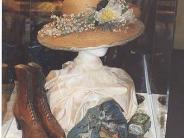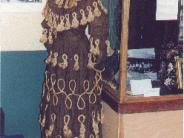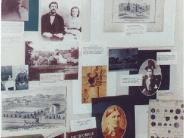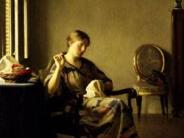Pincushions to Politics: Women in Nineteenth Century Santa Cruz County
The exhibit tells the stories of self-reliant women who lived in this area during the first decades of statehood. The stalwart pioneers are represented in the museum exhibit through photographs, books, period dresses, shoes, hats, poems, and, of course, a pincushion.
Pincushions to Politics: Women in Nineteenth Century Santa Cruz County
by Carolyn Swift - former Director, Capitola Historical Museum
Mrs. Frank Lewis had good reason to despise snow, or at least want to live as far away from it as possible.
As little girls, Martha Jane "Patty" Reed and her sister Virginia filled dainty porcelain tea cups with the freshly fallen powder and dipped it out with small spoons, pretending it was custard.
The winter scene of 1846-7 might have made a fond childhood memory had there not been the reality of starvation and death. Grisly scenes of horror and agony were a part of everyday life for Patty and her family as they struggled to survive one of the most terrible episodes in the history of the West.
Even as a child of eight years, Patty impressed her elders as a child with as much sense as a grown woman. She showed her spirit when the first Donner Party rescue team arrived and both she and her younger brother were found to be too small to endure the forty mile trek through high drifts to safety. Staying behind at the death camp at Alder Creek, Patty turned to her mother and calmly said, "Well, Ma, if you never see me again, do the best you can."
Finally saved and reunited, the Reed family took up residence in San Jose. In 1856, at the age of eighteen, Patty married Frank Lewis of Santa Cruz. Living in San Jose, the couple had eight children. The youngest was three years old when the husband died in 1876.
As a widow, Lewis supported herself as the proprietor of hotels in Santa Cruz and Capitola, including the grand 160-room Hotel Capitola, built by Frederick Hihn in 1890, and later the Capitola Park Hotel, off Park Avenue.
Capitola Park Hotel originally housed workers of the California Sugar Beet Mill, established nearby in 1874. When the mill was dismantled, Frederick Hihn, Capitola's developer, purchased the building and moved it to a site across the road from the train depot. Under the management of the Donner party survivor, the inn, known as the Lewis House, became a local favorite.
Patty Reed Lewis is among many remarkable pioneer women who helped build and improve life in Santa Cruz County in the 19th Century. This winder, the Capitola Historical Museum is featuring a number of these women -- suffragists, teachers, writers, mothers, artists, and activists -- in a show entitled Pincushions to Politics: Women in Nineteenth Century Santa Cruz County.
The exhibit tells the stories of self-reliant women who lived here during the first decades of statehood, when the region was isolated and roughly settled. The experience of little Patty Reed, for example, was chronicled in the writings of the first local women's rights advocate, Eliza Farnham, who arrived in Santa Cruz early in 1850.
A teacher and a nurse, as well as an author, reformer, and suffragist, Farnham was outspoken in her observations of Santa Cruz society. Determined to become a farmer and to build a house with her own hands, Eliza was joined in these pursuits by her friend Georgiana Bruce, a young woman who shared her activism. Together, they wore "Turkish pants" and delighted in the expanded roles open to women in the West.
Marrying tanner Richard C. Kirby in 1852, Georgiana was to spend the rest of her life in Santa Cruz, eventually bringing the legendary New England suffragists Elizabeth Cady Stanton and Susan B. Anthony here to lobby in behalf of votes for women.
While the advocates for women's rights were beginning to advance their cause, another woman exercised her liberty in a different way. Taking on the guise of a man, Charley Parkhurst became the celebrated female stage coach driver who actually voted in the national presidential election of 1868. Her true gender remained a secret until her death in 1879.
While these exceptional women stand out, numerous others have also made gifts to history even though their names are less well known. These stalwart pioneers are represented in the museum exhibit through photographs, books, period dresses, shoes, hats, poems, and, of course, a pincushion.
Patty Reed
New Light on the Donner Party: The Reed Family
Patty Reed Remembers about where her grandmother is buried
Patty Reed's Doll
Diaries of James F. Reed
History of the Donner Party
Eliza W. Farnham
California: Indoors and Out by Eliza Woodson Burhans Farnham,1815-1864.
Georgiana Bruce
Susan B. Anthony's Visit to Santa Cruz
Years of Experience A picture of her book
Charley Parkhurst
Adventures of Wells Fargo: Charlie Parkhurst
Charley Parkhurst
Shadows of the Past




